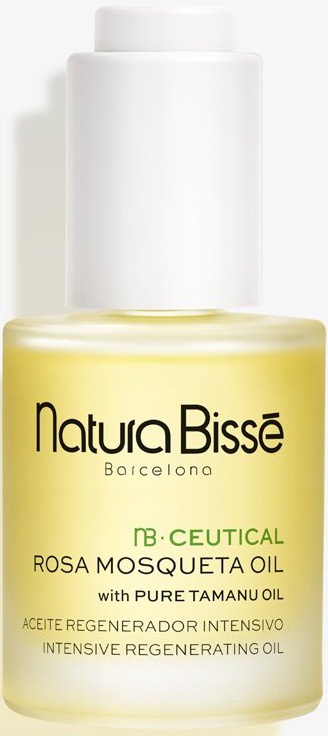
Rosa Mosqueta Oil
Highlights
Skim through
| Ingredient name | what-it-does | irr., com. | ID-Rating |
|---|---|---|---|
| Ethylhexyl Stearate | emollient | ||
| Rosa Canina Fruit Oil | emollient | ||
| Calophyllum Inophyllum Seed Oil | antioxidant, emollient, antimicrobial/antibacterial | goodie | |
| Tocopheryl Acetate | antioxidant | 0, 0 | |
| Calendula Officinalis Flower Extract | soothing, antioxidant, perfuming | goodie | |
| Fragrance | perfuming | icky |
Natura Bissé Rosa Mosqueta OilIngredients explained
A clear, almost colorless (or slightly yellowish) oily liquid (an ester to be precise) that's used as a medium spreading emollient. It gives skin a nice and smooth after-feel and it's very good at reducing oiliness or greasiness coming from other heavier oils in the formula.
Though it says fruit oil in its name, the rosehip fruit contains the seeds that contain the oil. So this one is the same as Rosa Canina Seed Oil, or Rosehip Oil, known for its high omega fatty acid content (linoleic acid - 51%, linolenic acid - 19% and oleic acid - 20%) and skin-regenerative properties.
There is a common misconception that rosehip oil contains vitamin C as the fruit itself does, but vitamin C is a water-soluble vitamin hence it is not contained in the oil. The antioxidant and regenerative properties of the oil probably come from the oil-soluble tocopherols (vitamin E) and carotenoids (pro-vitamin A). Read more here.
A green-yellowish oil coming from cool places like Tahiti, Bora Bora, and the island of Polynesia. Similar to other more common plant oils, it's loaded with nourishing and moisturizing fatty acids (oleic acid: 30-55%, linoleic acid: 15-45%, palmitic acid: 5-20% and stearic acid: 5-25%).
The special thing about Tamanu oil, though, is that it contains the totally unique fatty acid called calophyllic acid that is suspected to give the oil its amazing healing and regenerative properties. The traditional uses of Tamanu oil range from using it for all kinds of rheumatism (inflammation in joints) to burns, wounds, skin rashes, and chapped lips and modern studies do confirm the wisdom of the old Polynesians. In fact, the wound healing properties of Tamanu oil is so strong that it produces visible improvements even for old (older than 1 year) scars during a 6-9 week period.
Other than that, according to manufacturer info, Calophyllum Inophyllum Oil also has significant SPF boosting and antioxidant properties. This latter one is probably due to its significant vitamin E content with delta-tocotrienol (236mg/kg) being the main form in the oil.
Overall, Tamanu seems to be an amazing oil for skin that is in need of some regeneration and protection.
It’s the most commonly used version of pure vitamin E in cosmetics. You can read all about the pure form here. This one is the so-called esterified version.
According to famous dermatologist, Leslie Baumann while tocopheryl acetate is more stable and has a longer shelf life, it’s also more poorly absorbed by the skin and may not have the same awesome photoprotective effects as pure Vit E.
The extract coming from the popular garden plant Calendula or Marigold. According to manufacturer info, it's used for many centuries for its exceptional healing powers and is particularly remarkable in the treatment of wounds. It contains flavonoids that give the plant anti-inflammatory and antioxidant properties.
Exactly what it sounds: nice smelling stuff put into cosmetic products so that the end product also smells nice. Fragrance in the US and parfum in the EU is a generic term on the ingredient list that is made up of 30 to 50 chemicals on average (but it can have as much as 200 components!).
If you are someone who likes to know what you put on your face then fragrance is not your best friend - there's no way to know what’s really in it.
Also, if your skin is sensitive, fragrance is again not your best friend. It’s the number one cause of contact allergy to cosmetics. It’s definitely a smart thing to avoid with sensitive skin (and fragrance of any type - natural is just as allergic as synthetic, if not worse!).
You may also want to take a look at...
| what‑it‑does | emollient |
| what‑it‑does | emollient |
| what‑it‑does | antioxidant | emollient | antimicrobial/antibacterial |
| what‑it‑does | antioxidant |
| irritancy, com. | 0, 0 |
| what‑it‑does | soothing | antioxidant | perfuming |
| what‑it‑does | perfuming |





